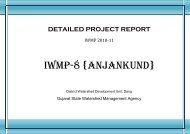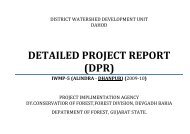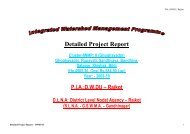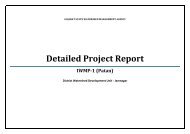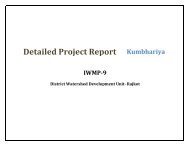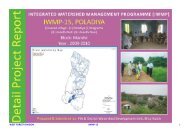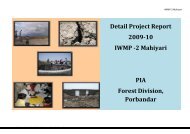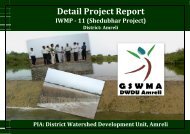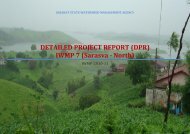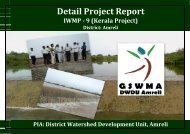IWMP-2 - Commissionerate of Rural Development Gujarat State ...
IWMP-2 - Commissionerate of Rural Development Gujarat State ...
IWMP-2 - Commissionerate of Rural Development Gujarat State ...
Create successful ePaper yourself
Turn your PDF publications into a flip-book with our unique Google optimized e-Paper software.
Detailed Project Report <strong>IWMP</strong>-2<br />
What is Organic Fertilizer?<br />
Organic Manure are naturally occurring Manure and nutrient enhancers <strong>of</strong> the soil. Therefore every substance that occurs naturally and is easily bio-degradable is<br />
organic and if this organic material enhances the richness <strong>of</strong> the soil, it is termed as organic fertilizer manures<br />
Objective<br />
The main objective <strong>of</strong> organic manure to soil fertility restoration is the supplying <strong>of</strong> nutrients and protecting the soil from both physical and chemical degradation.<br />
The decomposing green plant materials greatly stimulate microbial activities. If commercial nitrogen from inorganic Manure is not easily available or only at high<br />
price; organic manure is essential in supplying nitrogen to crops.<br />
1. To Increased crop yield even without minimum chemical fertilizer application<br />
2. To Improved chemical, physical, and biological properties <strong>of</strong> the soil, contributing to soil conservation<br />
3. To Increased farm incomes as a result <strong>of</strong> large savings on expensive chemical Manure<br />
4. Reduced agricultural wastes and enhanced rate <strong>of</strong> resource recovery<br />
Market feasibility <strong>of</strong> organic farming<br />
There is always abundant demand for Manure for it is used by farmers to improve their agricultural outputs. Raw materials that might be used as possible inputs to<br />
produce organic Manure are animal manure, agricultural residues, sewage sludge, composts, slaughter house wastes and municipality solid waste.<br />
Description Organic Conventional<br />
Size<br />
Relatively small-scale, independent operations (e.g. the family farm)<br />
Large-scale, <strong>of</strong>ten owned by or economically tied to major food<br />
corporations<br />
Methods<br />
Low use <strong>of</strong> purchased Manure and other inputs; low mechanization Intensive chemical programs and reliance on mechanized<br />
<strong>of</strong> the growing and harvesting process<br />
production, using specialized equipment and facilities<br />
Markets<br />
Often local, direct to consumer, through on-farm stands and farmers'<br />
markets (see also local food), and through specialty wholesalers and<br />
retailers (eg: health food stores)<br />
Wholesale, with products distributed across large areas (average<br />
supermarket produce travels hundreds to thousands <strong>of</strong> miles) and<br />
sold through high-volume outlets<br />
<strong>Gujarat</strong> <strong>State</strong> Watershed Management Agency<br />
123 | P a g e



